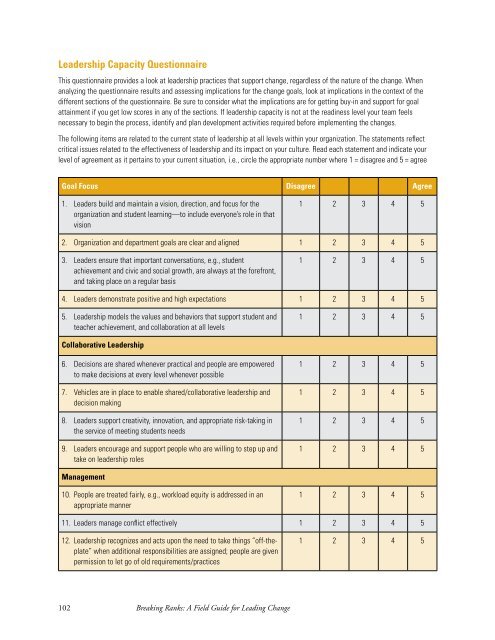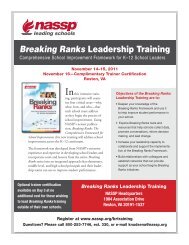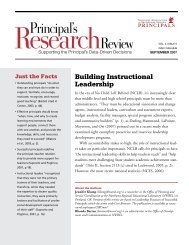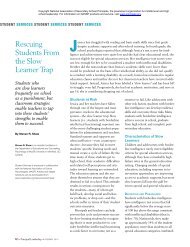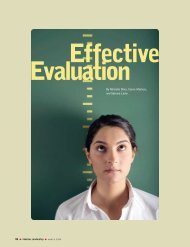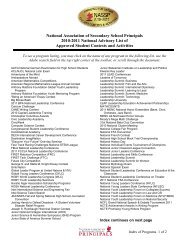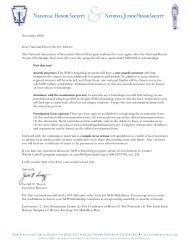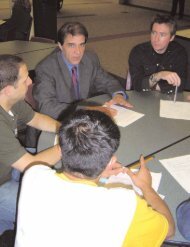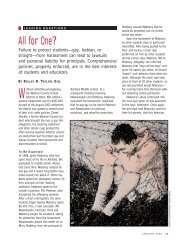Leadership Capacity Questionnaire
Leadership Capacity Questionnaire
Leadership Capacity Questionnaire
You also want an ePaper? Increase the reach of your titles
YUMPU automatically turns print PDFs into web optimized ePapers that Google loves.
<strong>Leadership</strong> <strong>Capacity</strong> <strong>Questionnaire</strong>This questionnaire provides a look at leadership practices that support change, regardless of the nature of the change. Whenanalyzing the questionnaire results and assessing implications for the change goals, look at implications in the context of thedifferent sections of the questionnaire. Be sure to consider what the implications are for getting buy-in and support for goalattainment if you get low scores in any of the sections. If leadership capacity is not at the readiness level your team feelsnecessary to begin the process, identify and plan development activities required before implementing the changes.The following items are related to the current state of leadership at all levels within your organization. The statements reflectcritical issues related to the effectiveness of leadership and its impact on your culture. Read each statement and indicate yourlevel of agreement as it pertains to your current situation, i.e., circle the appropriate number where 1 = disagree and 5 = agreeGoal Focus Disagree Agree1.Leaders build and maintain a vision, direction, and focus for theorganization and student learning—to include everyone’s role in thatvision1 2 3 4 52. Organization and department goals are clear and aligned1 2 3 4 53.Leaders ensure that important conversations, e.g., studentachievement and civic and social growth, are always at the forefront,and taking place on a regular basis1 2 3 4 54. Leaders demonstrate positive and high expectations1 2 3 4 55.<strong>Leadership</strong> models the values and behaviors that support student andteacher achievement, and collaboration at all levels1 2 3 4 5Collaborative <strong>Leadership</strong>6.7.8.9.Decisions are shared whenever practical and people are empoweredto make decisions at every level whenever possibleVehicles are in place to enable shared/collaborative leadership anddecision makingLeaders support creativity, innovation, and appropriate risk-taking inthe service of meeting students needsLeaders encourage and support people who are willing to step up andtake on leadership roles1 2 3 4 51 2 3 4 51 2 3 4 51 2 3 4 5Management10. People are treated fairly, e.g., workload equity is addressed in anappropriate manner1 2 3 4 511. Leaders manage conflict effectively1 2 3 4 512. <strong>Leadership</strong> recognizes and acts upon the need to take things “off-theplate”when additional responsibilities are assigned; people are givenpermission to let go of old requirements/practices1 2 3 4 5102 Breaking Ranks: A Field Guide for Leading Change
Goal Focus Disagree Agree13. Leaders have an accurate view of what is going on, i.e., individual orgroup needs and concerns1 2 3 4 514. Leaders stay in touch with people and get out from behind their desks 1 2 3 4 515. Leaders don’t shy away from the tough decisions—they use theirauthority appropriately16. Leaders don’t initiate major projects without getting the requisite buyinand doing all the homework necessary to ensure success17. Leaders maintain objectivity and an appropriate concern for the wellbeingof others, even under trying conditions1 2 3 4 51 2 3 4 51 2 3 4 5Development18. There is an ongoing and effective process by which it is determinedwho needs leadership development1 2 3 4 519. <strong>Leadership</strong> training exists and is effective for all.1 2 3 4 520. Sufficient resources and time are allocated for leadership training anddevelopment for all as appropriate.1 2 3 4 5Culture (a reflection of leadership)21. Students needs are put ahead of adult needs1 2 3 4 522. People trust, respect, and support one another as peers and acrosslevels23. People focus on the future and getting better, versus the past andblame1 2 3 4 51 2 3 4 524. People respect the authority and communication “chain of command” 1 2 3 4 525. People feel comfortable to speak freely to express new ideas1 2 3 4 526. People are prepared for and on time to meetings1 2 3 4 5Copyright 2009 William R. Bryan. All rights reserved.Ch a p t e r 6: Assess Readiness a n d Bu i l d Ca pa c i t y103


